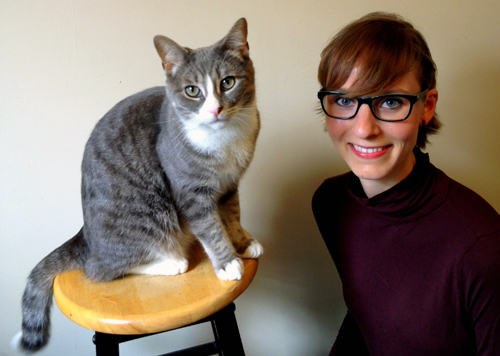
In some parts of the world, feral cats are losing all nine of their lives due to hunting and poisoning campaigns designed to control their population. Lauren Van Patter, a master’s student in geography, is trying to find out why people feel the way they do about feral cats and whether these animals belong in the communities where they were introduced.
“I’m interested in human-animal relations,” says Van Patter. “I’m interested in how we should be treating animals in our society.”
She started her undergrad at U of G in wildlife biology and then switched to environmental science, majoring in natural resources management. Rather than focus on how humans try to control animals as pets, food and wildlife, she decided to look at how people perceive animals and their role in society and nature. When she was looking for a supervisor for her master’s research, she turned to geography professor Alice Hovorka, who specializes in human-animal relations.
“At the time, I had one cat and I really saw him as a family member,” says Van Patter. Like many cat owners, she allowed her pet to go outside, but she struggled with the possibility that it could injure or kill a small animal. As a vegan, she also questioned the ethics of feeding her cat food containing meat.
More complications arose last year, when she and her partner rescued a baby bird that had fallen out of its nest. When they contacted a local wildlife rehabilitation centre, they were asked to care for the bird themselves because the centre was full. Again, she struggled with the centre’s advice to feed the bird meat-based puppy food.
Van Patter became interested in how humans relate to animals based on their role as pets, wildlife or food animals. She decided to focus her research on feral cats and their impact on the environment – an issue that many cities, including Guelph, are struggling with. “It’s such a contentious issue today,” she says.
The dual identity of feral cats as both wild and domesticated fascinated her, as did people’s perceptions of them. “They often cause a lot of conflict with people who want to care for them and maybe see them as a species that can become naturalized wildlife versus people who see them as invasive, introduced and unnatural,” she explains. Some people may see them as unnatural because of the human influence of domestication.
Cats are often blamed for the deaths of small animals such as birds, she says, but controversy surrounds how many of those deaths can be attributed to cats. Some people believe that feeding feral cats will reduce their need to hunt, but she says research on the topic has been limited and inconclusive.
“Beyond the potential damage to wildlife, there are other considerations such as nuisance, the danger to the cats themselves through predation or being hurt by other animals or being killed by cars,” says Van Patter. There is also concern that cats may carry rabies or parasites that can be transmitted to other animals or humans, she adds.
Some municipalities are currently trapping feral cats and spaying or neutering them to help slow their population growth. Other municipalities have introduced cat licensing to discourage owners from abandoning their pets. Van Patter says she doesn’t support the idea of exterminating feral cats, especially since humans created the problem.
“I think that it takes a lot of critical thought about whether or not humans should even be managing other species like that,” she says. “In our society, it often comes down to how much benefit or utility an animal has to have in order to be seen as belonging somewhere.”
For her research, she plans to interview people with a variety of opinions on feral cats. She’s also interested in how they perceive feral animals and the role humans can or should play in controlling their population.
“The more I research these issues,” she says, “the more complicated I realize it is.”